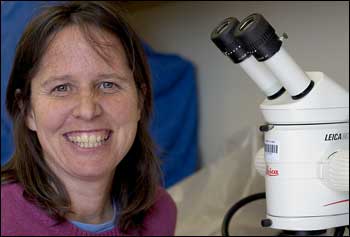Unlike most people who go to rivers to watch them flow, Jane Marks goes to rivers to help them flow.
Marks, an associate professor in the biological sciences department, is developing ways to help rivers rebound to their natural ecosystems after dams are removed. Her first-hand experience of dam-removal research is featured in the March 2007 issue of Scientific Americanmagazine.
Marks’ six-page article, “Down Go the Dams,” not only reports on the ebb and flow of her efforts to restore Arizona’s Fossil Creek to its natural habitat, it also provides an up-to-date account about current dam decommissionings and why a trend exists to restore rivers to their natural flow.
“Dams are coming down because they are outliving their usefulness and because people are placing a higher value on natural ecosystems,” Marks said in an interview. “Many of the hydropower dams that are coming down generate very little power, and the energy can be produced by other means or simply absorbed by energy conservation measures.”
Marks uses her experience working as a teacher, scientist and researcher on restoring Fossil Creek’s natural habitat to help others understand some of the issues they may face during dam decommissioning.
“Those of us who have witnessed many of the unexpected consequences of dam removals are now using that knowledge to try to minimize negative results in the future,” Marks said.
According to Marks, the downside to dam decommissioning includes the release of sediments stored behind them and the potential introduction of non-native exotic species. She believes both of these downsides can be mitigated with proper management.
Her work on Fossil Creek included helping state and federal managers rid the waters of non-native fish that flourished in the disturbed river below the dam.
Her team, composed of graduate and undergraduate students, helped the managers remove all of the fish and only return native fish to the restored creek. NAU graduate students worked side by side with state and federal managers to document how many exotic fish were removed and how many native fish were returned. NAU doctoral student Eric Dinger studied the side effects of the chemical treatment on stream insects.
|
“Fossil Creek will serve as a national case study in dam decommissioning because a group of NAU scientists, as well as members of the national and state agencies, began studying the ecosystem years before the dam was decommissioned,” she explained. “It is one of only a handful of dam decommissionings where we will be able to tell if and how the ecosystem rebounds.”
Marks said an integrated team of scientists from NAU have been studying all aspects of the creek’s restoration.
“This is the only dam decommissioning in the world where such a diverse team of scientists have joined forces to study the costs and benefits of restoration,” Marks noted.
The NAU team included Marks, hydrologist Abe Springer, an associate professor in geology; geologist Rod Parnell, director of geology; engineer Charlie Schlinger, an associate professor in civil and environmental engineering; social scientist Martha Lee, a forestry professor; biologist Maribeth Watwood, chair of biological sciences; and biologist Bruce Hungate, a professor in biological sciences.
Marks began work on Fossil Creek about five years ago. She will continue to study the reformation of its travertine dams, as well as document the recovery of the creek’s native species for the next 10 years.
Students will continue to be involved with her research.
“Students have been the people who have spent weeks in the field gathering information and even helping managers rid the stream of exotic fish,” Marks said. “We have more than 10 graduate students whose thesis research revolves around Fossil Creek and more than 100 others (undergraduate and graduate) who have helped.”
The article in Scientific American magazine is available for purchase online.



